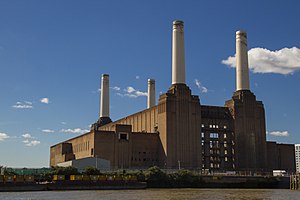
Back محطة باترسي Arabic ব্যাটারসি বিদ্যুৎ কেন্দ্র Bengali/Bangla Battersea Power Station Catalan Elektrárna Battersea Czech Battersea Power Station Danish Battersea Power Station German Battersea Power Station Spanish نیروگاه بترسی Persian Battersean voimalaitos Finnish Battersea Power Station French
| Battersea Power Station | |
|---|---|
 Battersea Power Station Viewed from the north bank of the Thames in August 2012 | |
 | |
| Official name | Battersea A and B power stations |
| Country | England |
| Location | Nine Elms, Battersea |
| Coordinates | 51°28′54″N 0°8′41″W / 51.48167°N 0.14472°W |
| Status | Decommissioned and redeveloped |
| Construction began | 1929 (A station) 1945 (B station) |
| Commission date | 1933–35 (A station) 1953–55 (B station) |
| Decommission date | 1975 (A station) 1983 (B station) |
| Construction cost | £2,141,550 (A station) |
| Owners | London Power Company (1939–1948) British Electricity Authority (1948–1955) Central Electricity Authority (1955–1957) Central Electricity Generating Board (1957–1983) |
| Employees |
|
| Thermal power station | |
| Primary fuel | Coal |
| Secondary fuel | Oil (A station only) |
| Power generation | |
| Units operational | A station: Two 69 MW Metropolitan-Vickers (MV) British Thomson-Houston and one 105 MW Metropolitan-Vickers B station:Two 100 MW and one 72 MW Metropolitan-Vickers |
| Nameplate capacity | 1935: 243 MW 1955: 503 MW 1975: 488 MW 1983: 146 MW |
| External links | |
| Website | batterseapowerstation |
| Commons | Related media on Commons |
Listed Building – Grade II* | |
| Official name | Battersea Power Station |
| Designated | 14 October 1980 |
| Reference no. | 1357620 |
Battersea Power Station is a decommissioned coal-fired power station located on the south bank of the River Thames in Nine Elms, Battersea in the London Borough of Wandsworth. It was built by the London Power Company (LPC) to the design of Leonard Pearce, Engineer in Chief to the LPC, and CS Allott & Son Engineers. The architects were J. Theo Halliday and Giles Gilbert Scott. The station is one of the world's largest brick buildings and notable for its original, Art Deco interior fittings and decor.
The building comprises two power stations, built in two stages, in a single building. Battersea A Power Station was built between 1929 and 1935 and Battersea B Power Station, to its east, between 1937 and 1941, when construction was paused owing to the worsening effects of the Second World War. The building was completed in 1955. "Battersea B" was built to a design nearly identical to that of "Battersea A", creating the iconic four-chimney structure.
"Battersea A" was decommissioned in 1975. In 1980 the whole structure was given Grade II listed status; "Battersea B" shut three years later. In 2007 its listed status was upgraded to Grade II*. The building remained empty until 2014, during which time it fell into near ruin. Various plans were made to make use of the building, but none were successful.
In 2012, administrators Ernst & Young entered into an agreement with Malaysia's S P Setia and Sime Darby to develop the site to include residential, bars, restaurants, office space (occupied by Apple and others), shops and entertainment spaces. The plans were approved and redevelopment commenced a few years later. The main Power Station building was opened to the public in October 2022.
As of 2023, the building and the overall 42-acre (17 ha) site development is owned by a consortium of Malaysian investors.
The station is also notable for its appearance on the cover of rock band Pink Floyd's tenth studio album Animals (1977).